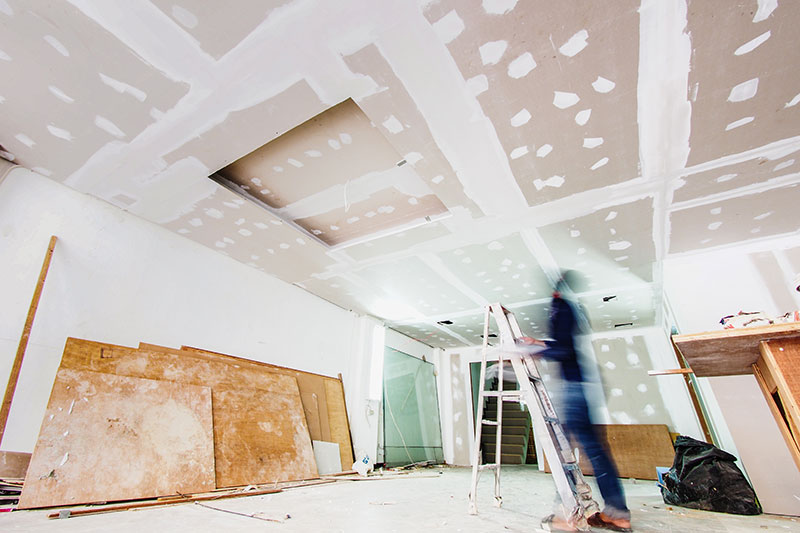The drywall is a durable material, but it can sustain damages at some point. The gypsum-board walls can end up with ugly-looking holes, dents, or cracks in the long run. It’s good to know that drywall is easy to fix, but you should do it properly. As a homeowner, fixing it can help save time and money.
Drywall, also called plasterboard, sheetrock, or wallboard, is available in the market since 1916. It’s a popular building material due to its affordable price and easy installation. Sadly, it has its share of downsides such as being prone to damage from random bumps, heavy furniture, or leaking pipes within the walls. If you want to learn about drywall repair, checking out reliable service providers would greatly help.
When the ceiling or walls have evident cracks, dents, or blemishes, you have no other choice but to fix them to keep your home looking at its best. Although hiring a professional to tackle significant repairs or new installation is the best choice, you can deal with minor repairs.
If you have some minor damage on one of the walls or ceilings in your home, here are drywall repair mistakes you need to be familiar with:
- Adding Too Much Mud
During the repairs, the amount of mud you apply will determine the overall smoothness of the finish. If you’re going to use too much mud, the tape ends will become too wet and eventually tear off. On the other hand, applying a small amount will not allow the tape to embed on the joint well.
Make sure to press the tape to squeeze out any excess mud before placing the final coating. To learn more, watching this following video can help.
- Placing Excess Pressure
When carrying out drywall repairs, you should be careful when distributing the compound under the tape. If you impart too much pressure on the knife, you’re likely to move the tape or cause it to rip apart. Leveling out the mud in a gentle manner will allow the tape to bind correctly.
- Using The Incorrect Knife
When working on a drywall repair task as part of your home improvement project, you need to be ready with several knives in various widths, depending on the work you’re handling.
If your priority is to eliminate any ridges and bumps, it’s best to utilize a small 6-inch knife. When applying the final coating, you need to use a wider knife, ideally 12-16 inches. Dealing with the repair using the right knife will make your task manageable and ensure a smooth finish.
- Applying A Thick Coating
When applying the joint compound, you should stick with three coats only. Upon placing the second layer of coating, you should still be able to see the tape.
If you could no longer see the tape upon applying the second filling, it simply means the layer is thick. If you make the coating too thick than usual, it’ll result in bulges while the surface appears uneven. Make it a point to work with thin layers.
- Not Prioritizing The Interior Corners
It’s essential to work on the interior corners first, so they have enough time to dry. The corners can be challenging to work with, especially if you’re utilizing screws or nails to secure the boards together.
It’d be best to utilize a wide knife to make it manageable to level the mud in the corners. If you apply the first coating properly, you need minimal sanding after the last layer.
- Drywall Mud With Wrong Consistency
If you’re planning to use a pre-mixed compound, be ready for issues along the way. It’s crucial to ensure the mixture has a good consistency and avoid using it when it’s too thick.
Make sure to add a small amount of water to the pre-mixed compound. If you’re going to use the thick compound, bubbles will likely form and the tape won’t stick securely on the wall. On the other hand, if the mixture is too thin, it can cause the tape to tear once you squeeze it.
- Not Removing Ridges And Bumps
One of the usual mistakes when repairing the drywall isn’t smoothening the surface by eliminating any ridges or bumps. Avoid covering these errors by applying a fresh coating of the compound. The best move is to scrape off any bumps with a knife once the compound fully dries up. It’s best to do this a day after applying the last coating.
- Incorrect Direction When Swiping
When you swipe the mud in a vertical direction or down, it increases the likelihood for the tape to tear apart. The ideal way to avoid this error is swiping horizontally from one corner to the other.
Conclusion
Once the time comes when you need to deal with a minor drywall repair job in your home, it’s crucial to carry out the task correctly to avoid additional issues along the way. Ensure that you’ll avoid these common mistakes when repairing the drywall to get the best outcome and keep your home looking good for several years.
